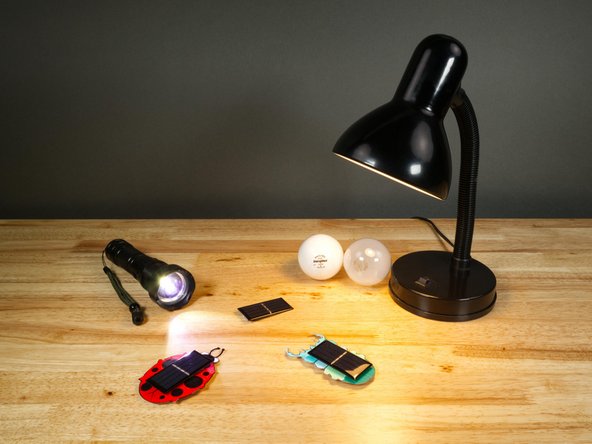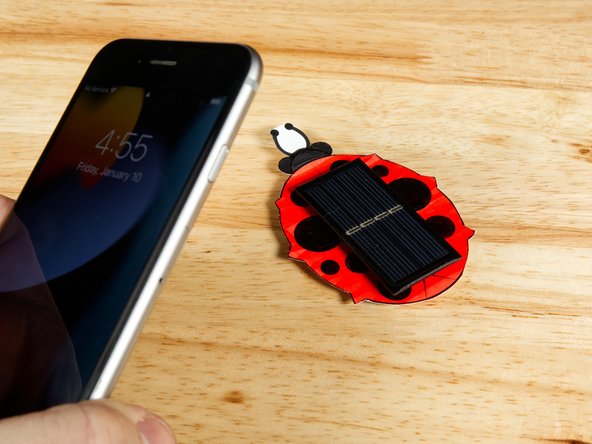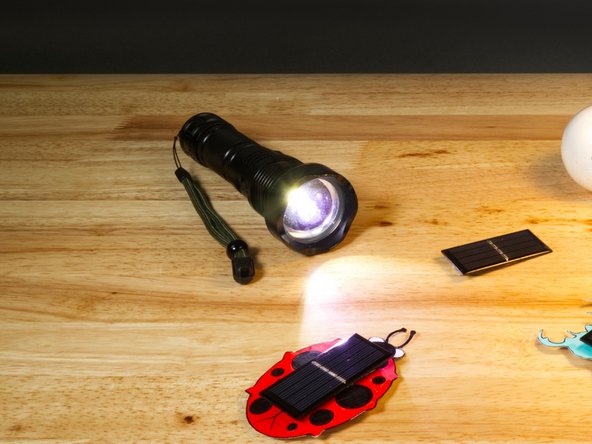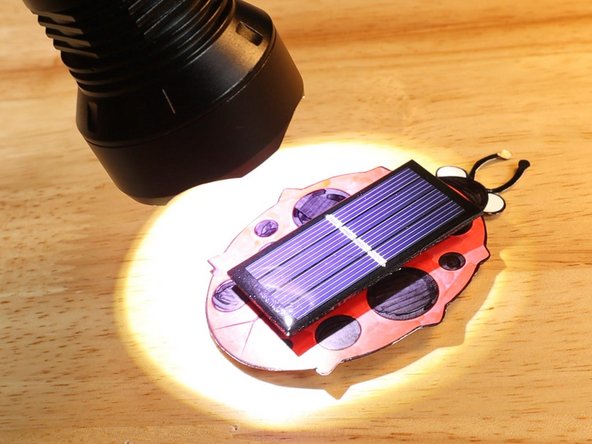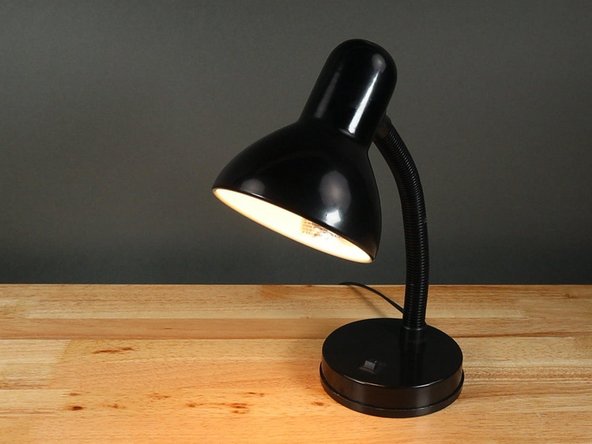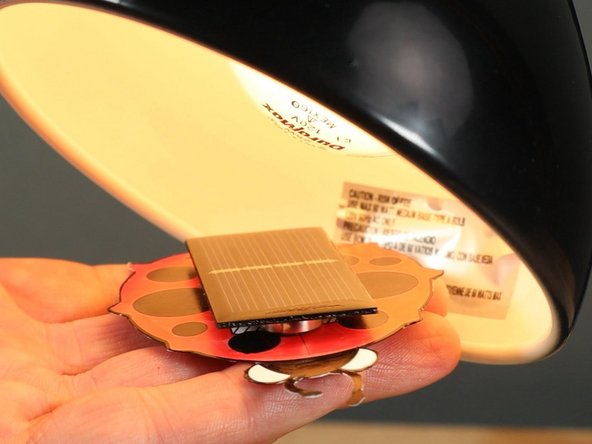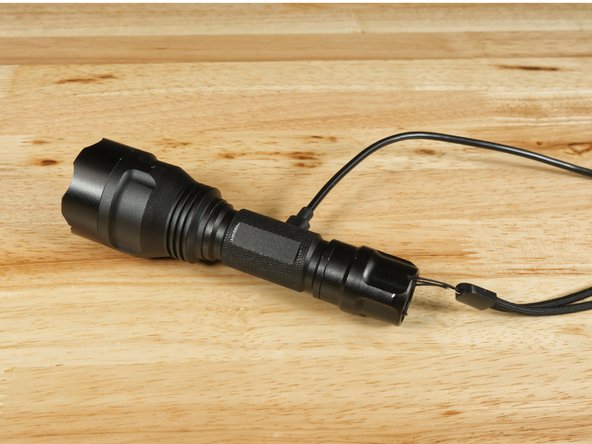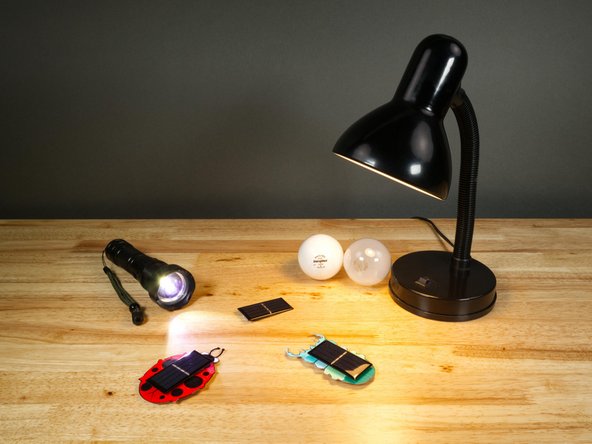Introduction
We've got a lot of solar projects and to make them work they typically need sunlight, which is going to be strongest if you go outdoors. But what if you can't go outside? Can you still use (or at least test) solar projects indoors? We'll walk through a few options in this guide.
Video Overview
-
-
We'll use our Solar Bug for this guide, but we'll include notes on some of our other solar projects as well.
-
Once you've assembled a Solar Bug your best bet is to run outside and put it in direct sunlight.
-
But what if there's no sunshine? What if it's raining? Or the sun has already set?
-
We've got a few suggestions...
-
-
-
You'll be tempted to turn on your phone's flashlight and shine it at the solar panel...
-
Don't bother. It won't work.
-
While it may appear bright if you look directly at it, your phone just has a tiny LED and not enough power to get a solar panel to react.
-
No phone. It will not work.
-
-
-
If you're indoors and it's sunny outside you may be tempted to run to the window and hold your Solar Bug so the sun hits it.
-
This might work. It depends on the window. Some glass blocks UV light and weakens the amount of solar power that can get through.
-
Some windows have a darkening tint added to them or a reflective surface on the outside.
-
Keep in mind that even if it does work, the glass may diminish the amount of power provided when compared to direct sunlight outdoors.
-
Our quick test (as seen in the video) shows a Solar Bug working great through a window on a typical sunny day. (Our window has no tint or reflective surface, but with anything testing is always helpful.)
-
This is the one time it might be better to be in an old building rather than a newer one that has Low-E glass windows. (Low-E glass windows minimize how much ultraviolet light passes through them.)
-
-
-
We've already mentioned that the flashlight on your phone will not work, but what about a "normal" flashlight?
-
Most cheap (low-powered) flashlights will not work, but we have had good luck with a high-powered LED flashlight.
-
We bought a pair of "Super Bright" rechargeable LED flashlights from Amazon that do get the Solar Bug moving.
-
-
-
You do need to hold the LED flashlight very close to the solar panel, practically touching it, but if you hold the Solar Bug in your hand you will be able to feel it vibrating.
-
The LED flashlight is listed as having "990,000 Lumens" which may not be accurate, but if you search for "990,000 Lumen flashlight" you should get some good options.
-
While the LED flashlight is a nice (and portable) option, it can be expensive.
-
We have another option...
-
-
-
We used a cheap desk lamp that uses standard E26 bulbs. (E26 is the classic "normal" light bulb in the US that has been around forever, before LED lights became popular.)
-
Don't get a desk lamp that has a built-in LED, you'll want a lamp you can screw a light bulb into.
-
Hopefully you can find one for under $20 USD. Here's one lamp and another lamp.
-
You will need to plug the lamp in, so it's not as portable as the LED flashlight option, but it does allow us to experiment with different bulbs.
-
-
-
We tested a few different bulbs including an LED bulb and two different incandescent bulbs.
-
The LED bulb has the following specs: 720 lumens, 8.5 watts, 2700k color temperature.
-
The incandescent bulbs were a standard 60 watt incandescent bulb, and a 25 watt incandescent appliance bulb.
-
Note that in some locales you may not be able to purchase standard incandescent bulbs but you should still be able to purchase low-wattage appliance bulbs.
-
-
-
The LED bulb is the safest bulb to use, as it does not really get hot or even very warm.
-
The 60 watt incandescent bulb can get quite hot, and could cause a burn. Please exercise caution!
-
The 25 watt incandescent appliance bulb gets warm but not hot, and should be relatively safe.
-
-
-
Our results with a 60 watt incandescent light bulb and a Solar Bug were very good.
-
We were able to point the desk lamp down towards the table and slide a Solar Bug under it to get it moving.
-
This allows hands to stay far enough away from the bulb that it should be fairly safe.
-
-
-
The 25 watt incandescent appliance bulb did not fare quite as well as well as the 60 watt incandescent bulb
-
We needed to hold the Solar Bug in our hand and put it right up to the bulb.
-
The nice thing about holding the bug between your hand and the bulb is that you should be able to feel the bug vibrating.
-
If you cannot get a standard 60 watt incandescent bulb where you live then a 25 watt incandescent appliance bulb should work.
-
-
-
The LED bulb is probably the safest and easiest to source, but also had the worst results.
-
We had to basically hold the solar panel on the bug right up against the bulb to get it to (very) lightly vibrate.
-
It did work, but it was the worst performance of all three bulbs.
-
Still, if an LED bulb is the only option, it's better than nothing.
-
-
-
The "990,000 Lumen LED flashlight" we have does manage to get the bug moving when held directly above the solar panel.
-
We have used this for years at events when we need to demonstrate the Solar Bug indoors.
-
We do recommend having someone hold the bug in their hand and then putting the flashlight a few millimeters above it.
-
This should be just enough power for the person to feel the bug vibrating.
-
And the LED flashlight does not get hot, so there should be no chance of burns when using it.
-
-
-
Make sure the LED flashlight is fully charged! It will work much better at full power.
-
The LED flashlights we have has five different modes: full, dim, dimmer, strobe, and what appears to be SOS mode.
-
Make sure the LED flashlight is in the brightest mode when using it.
-
Ours changes mode with each press of the power button, and to turn it off you hold the button down for a few seconds.
-
It's a good idea to get familiar with your specific LED flashlight to make sure you know how it works.
-
-
-
If you've built Solar Bugs or Solar Critters and want to test them while indoors, you have a few options.
-
If you have sunlight coming in through a window, give that a try... it might work fine!
-
If you have a desk lamp and can add an appropriate light bulb give that a try.
-
If you are able to get a super-strong LED flashlight it's a great portable option that doesn't need an outlet to operate.
-

